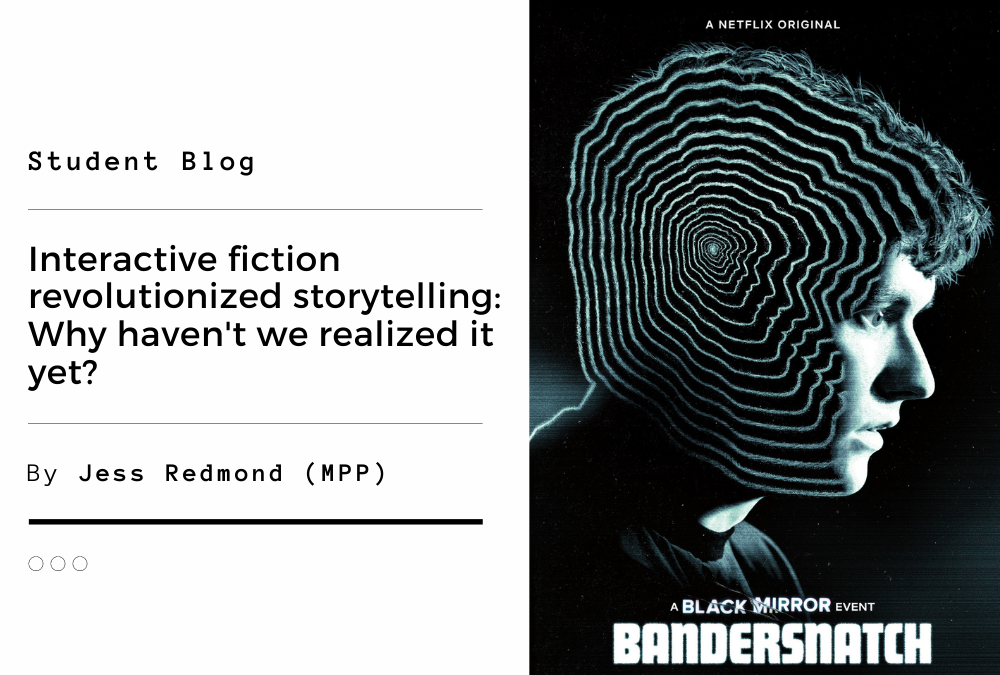Technology allows stories to be truly interactive. Yet the efforts of creative and experimental authors too often remain obscure.
The start of a story is a leap into the unknown. Familiar rituals ease us into that uncertainty- the texture of paper, a book spine creaking, perhaps the comforting weight of a tablet reader. We rest in the knowledge that the author has determined where we are going. As the reader, we are simply there for the ride.
Few of us think of stories that start with the click of a hyperlink. Fewer still imagine that as the reader we can have the power to decide the journey the story will take . Yet these experiences are familiar to enthusiasts of Interactive Fiction, who emerged from the choose-your-own-adventure books and text-based computer games of the 1960s-80s into a buzzing community of online artists. As Netflix pilots its own interactive storytelling formats through interactive specials such as Bandersnatch, it is time to elevate this format into the mainstream, instead of dismissing interactive stories as ‘games’.
The key difference between interactive and traditional fiction is the agency of the reader. Rather than passively ‘receiving’ a story from a book or movie, with Interactive Fiction the reader must engage in choices, solve puzzles, or perform tasks to move the story along. This simple difference belies a radical shift in storytelling from a one-way channel into a two-way conversation. A typical novel contains gaps – in meaning, in explanation, sometimes in plot – that the readers is left to interpret. In interactive fiction, the reader can fill in those gaps, and watch how the story responds.
The best examples of the genre showcase its immersive power – how the frustrations, fears and hopes in a narrative can be felt directly by you, who are not just the reader but the co-creator. howling dogs by porpentine traps us in a disintegrating room of dark metal that the reader desperately tries to escape through vividly described virtual realities. Galatea by Emily Short disorients you through conversation with a sculpture that has unexpectedly come to life. Hana Feels by Gavin Inglis emphasizes the tension between intervening and listening as you try to help a young girl in crisis.
So why has this potential gone unnoticed for so long? Part of the answer lies in what readers and critics choose to deem as ‘literature’. Interactive Fiction more easily falls into the category of ‘video game’. To many critics, including art critic Jonathan Jones and the late Pulitzer Prize winning critic Roger Ebert, this disqualifies interactive fiction from holding artistic merit. For many adults, it disqualifies interactive fiction from any engagement at all.
On closer examination, this is an arbitrary distinction. That video games are viewed as young people’s entertainment is marketing, not truth. Art critics claim that we cannot understand the artists’ vision if they have ceded their responsibility for storytelling to the player. Yet the possibility of reader agency has been teased in many famous works of literature, from If On A Winter’s Night a Traveller to Pale Fire. In interactive fiction authors express themselves not just through prose but in the design of the journeys a reader can take, and the spaces left empty for the reader to fill.
Another reason for the obscurity of the genre is that much of the scene lies in amateur makers, without the assistance of a publishing house or MFA program to raise their profile. Through open source software such as Twine, the tools to make and publish interactive fiction are free and accessible. As a result, the diversity of the genre is staggering. However, another consequence of low barriers to entry is that finding quality requires a commitment to scouring the internet that often only enthusiasts can afford.
The big budget experiments of Netflix could take interactive storytelling into the spotlight. Yet what a loss if we don’t bring with it the creativity and experimentation of what has been produced before. As readers, we should challenge arbitrary distinctions between what can and can’t be ‘literature’ and consider how we can showcase amateur authors. The best way to start is to dive into top-rated reads on the Interactive Fiction Database, experience the genre for yourself, and recommend to others gems you find. Published critics should include reviews of compelling pieces in their columns. Netflix could also support creators by hosting interactive fiction content on its platform, rather than solely promoting its own high budget material.
My discovery of interactive fiction came as a closeted teenager, diving into the internet to find a place where I could see myself reflected. The scene has long been a refuge for queer and other marginalised authors seeking representation, because at the centre of every interactive fiction piece is a space for the reader to be themselves. These radical underpinnings show us that shared power doesn’t dilute the potency of storytelling. It transforms it into something new.
